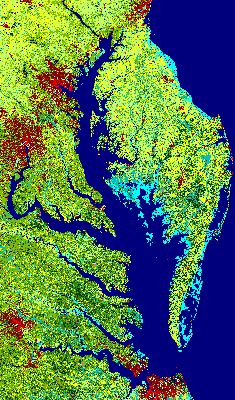
A satellite view of the Chesapeake Bay
and surrounding land areas.
Red shades show urban land,
yellow indicates agriculture,
and green areas are forested.
|
Methods. The methods sections describe
the specific procedures that are employed for
field data collection,
laboratory analysis of samples,
statistical assessment, and
calculation of an index of biotic integrity
that measures the health of the Bay. Benthic
samples are collected using four kinds of gear depending on the program element and
habitat type. Species-level identifications and ash-free dry weights
are provided. Nonparametric statistical techniques are used to determine
trends in benthic condition at the fixed stations, and probability-based
sampling is used to make inferences about areal extent of degradation.
Accomplishments. Over the past 15 years, the Maryland and
Virginia Benthic Monitoring Programs have pioneered many important
developments and techniques for understanding the Chesapeake Bay and
estuarine environments in general. After a period of initial research
into ways in which benthic communities could be used to measure and
monitor environmental conditions in the Bay, the Program developed
a benthic index of biotic integrity (B-IBI). The B-IBI was subsequently
tested and verified and then applied to critical assessment issues,
including relations between benthic community condition and
water quality, sediment quality, and
watershed stressors. More recently, advanced tools based on the
B-IBI have been developed, including better ways of estimating
condition and diagnostic tools for
classifying regions of the Bay affect by contaminants. The Program has also
developed biological criteria based on the B-IBI to assist in the
impaired waters assessments required by the Clean Water Act (303d
lists). Further
details and references for these accomplishments are available in the
PDF document Maryland and Virginia Benthic
Program Developments.
|